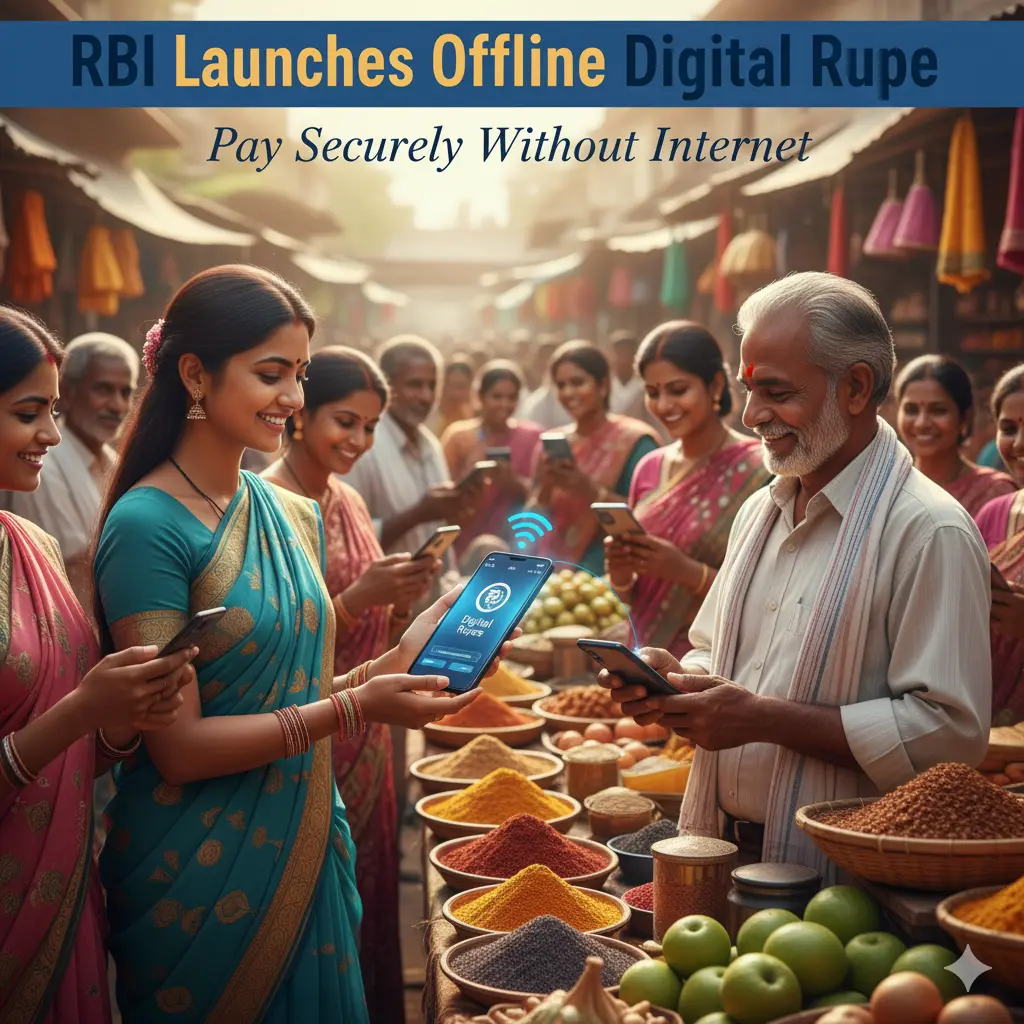RBI Launches Offline Digital Rupee: Make Payments Without Internet
The Reserve Bank of India (RBI) has taken a landmark step in India’s digital payment ecosystem by officially launching the Offline Digital Rupee (e₹) at the Global Fintech Fest 2025 held in Mumbai. This revolutionary digital currency by the central bank enables users to make secure, instant payments even without an active internet or mobile network connection — a first in large-scale digital currency deployment globally.
What Is the Offline Digital Rupee (e₹)?
The Offline Digital Rupee (e₹) is the electronic form of the Indian Rupee issued directly by the RBI, carrying the same legal tender status, sovereign guarantee, and trust as physical currency notes. Unlike payment platforms such as UPI, which move funds between bank accounts via the internet, the digital rupee functions as real digital cash. It allows peer-to-peer (P2P) and person-to-merchant (P2M) transactions through digital wallets issued by banks, offering the convenience of cash with enhanced safety and programmability.
How Does the Offline Feature Work?
The most significant innovation in this launch is the ability to make payments offline, crucial for users in areas with poor or no internet connectivity such as remote villages or during network outages. The offline functionality works in two main ways:
- Near Field Communication (NFC) Tap Payments: Two devices equipped with NFC technology can simply tap to transfer digital rupees directly, without needing any internet or telecom connectivity. This works like the classic physical cash exchange but in a fast and secure digital manner.
- Telecom-Assisted Offline Payments: Using minimal network signals, users can initiate transactions in areas where connectivity is extremely weak. This system is reliable even if traditional data connections are unavailable.
Participating Banks and Wallets
Fifteen major banks have been selected as participants for this rollout, including State Bank of India, ICICI Bank, HDFC Bank, Union Bank of India, YES Bank, and Bank of Baroda. These banks provide dedicated digital wallets for users, which can be downloaded from Google Play Store or Apple App Store for smartphone users. The wallets have a maximum balance limit of ₹1 lakh and daily transaction limits of ₹50,000 or 20 transactions to ensure security and control.
Programmable Money for Specific Use Cases
Unlike physical cash, the digital rupee can be programmed with specific rules and restrictions. This includes:
- Funds that can only be used for a predetermined purpose, such as government subsidies
- Expiry dates on money to ensure timely spending direction
- Geo-fencing to restrict transactions to certain locations or merchant categories
This programmable nature is already touted and tested in government initiative pilots, such as Gujarat’s G-SAFAL subsidy scheme and Andhra Pradesh’s DEEPAM 2.0 program, enabling transparent and targeted delivery of welfare benefits.

Also Read:- Next-Gen Bajaj Chetak EV Spied – Launch & Specs Leaked
Impact on Financial Inclusion and Digital Trust
RBI Governor Sanjay Malhotra emphasized that the offline digital rupee would immensely boost financial inclusion by enabling digital payments in financially underserved and connectivity-poor regions. This initiative strengthens India’s Digital Public Infrastructure and supports the growth of a trusted, scalable fintech ecosystem that emphasizes security and user convenience.
By allowing digital payments without internet reliance, the RBI aims to bring millions of previously excluded users into the formal economy while maintaining strong safeguards against fraud and money laundering.
Security and User Convenience
The digital wallets built for e₹ transactions include features for device loss protection, allowing users to recover their wallets safely. Transaction data is secured with encryption standards mandated by RBI, ensuring the integrity and confidentiality of funds transacted.
This blockchain-based, offline-compatible financial infrastructure paves the way for an efficient, cashless India that adapts to the realities of Indian consumers, especially those living in rural and remote areas.
How to Get Started?
Users can download digital wallets from participating banks’ official app stores. After completing registration and identity verification, they can start using e₹ for payments in offline or online mode. Merchants are encouraged to upgrade POS devices to accept NFC payments to capitalize on this new payment mode.
Conclusion
The RBI’s offline digital rupee launch is a game changer in India’s payment landscape, offering a perfect blend of digital convenience and offline usability. It enhances India’s position as one of the pioneering nations in Central Bank Digital Currency (CBDC) deployment with advanced features such as offline transactions, programmable money, and strong security frameworks.
As adoption spreads through banks and merchants nationwide, e₹ promises to make digital payments accessible, inclusive, and equitable, truly making India’s vision of a less-cash, digitally empowered economy a reality — even in the most connectivity-challenged corners of the country.
For more such updates and latest news on cars and bikes stay connected to times.motormitra.in
Thank you ..

